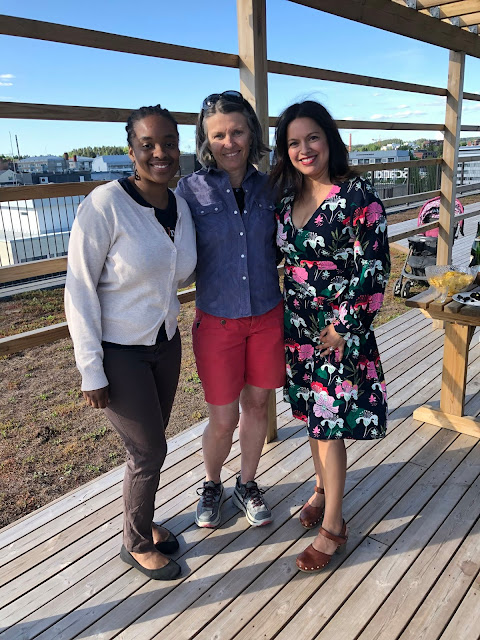Here's what I said today:
Good afternoon, everyone, my name is Martha Infante, and I thank you all for inviting me to speak on the issue of Educational Equity as it relates to schools in California and the nation. I, like David Cohen, am a member of the Accomplished CA Teachers Network, am Nationally Board Certified, and am currently a middle school history teacher in an urban, industrial area of Los Angeles.
My educational background began in the public schools of East Los Angeles in the 1970’s. I was fortunate to partake in a strong Gifted and Talented Education program and received a robust and fulfilling arts education as well. As a graduate of UCLA, I continued benefitting from the investment made by the state in public schools and chose to return the favor by becoming a public school teacher in the hardest to staff area of the Los Angeles Unified School District: South Central Los Angeles where I have dedicated my service for 20 years. In this time, I believe I have gained an insight that may serve the purposes of this committee and I will share the experiences of my students, as well as observations I have made of the various programs that have been created to reverse the educational inequities that have existed in schools for many, many years.
The state of education funding today has hit schools like mine in a way few have come to know. Increases in class size are common, and limited classroom resources are the immediate, obvious results. However, it is the precipitous state of the whole child that is affected in urban schools, when cuts hit hard and often. Students with special needs such as autism and dyslexia appear in overcrowded classrooms but their needs go unnoticed by the predominantly novice teachers which tend to be employed in hard to staff schools. Training to recognize the warning signs of emotionally disturbed students has virtually ceased due to the marked decrease in professional development funds, and even if funding were available, it is usually geared toward training in reading and math as this has been the focus of No Child Left Behind. In the past year, our school counselors loads have doubled from 350 students per counselor to 700. With further cuts looming, the number will surely rise. Parents in my community are workers and do not often have the time to interact with the school as often as necessary, or the knowledge of warning signs they must look for to tell them that their child is at risk. As such, the school becomes the last, best hope to help students before they become a danger to themselves. In the past 12 months, I have identified two students with Aspergers, a suicidal student, and a student being physically abused at home. These students had gone unidentified by other novice teachers on campus and missed by their counselor due to the tremendous strain of reduction in support services in the last several years. I shudder to think what would have happened to these students if the teacher in front of them had been a new teacher, and at the same time realize that many such students have already slipped through the cracks.
My initial comments have focused on support services by counselors and mental health professionals because all teachers know that if a student’s basic needs of safety and security are not met, then learning is not happening in the classroom. However, even in the best of times when schools have been fully staffed in this area, the issue of equity continues to be prevalent. Staffing has been a constant issue in schools like mine because of difficult working conditions, and the depth of social, emotional, and economic problems that my students face. These conditions have been known to defeat even the most valiant of educators because all workers like to believe there is a light at the end of the tunnel. Working at urban schools sometimes means surviving, not knowing if your colleagues will return to work the next day, whether your principal is there to make a difference or just passing through, and learning to fend for yourself when it comes to acquiring the necessary resources to teach students. As a result, teacher turnover is extremely high in urban schools, and the learning curve is very steep for the rookie teachers who are relegated to teach in these communities. Burn out is even higher at charter schools, and I wonder whose children suffer because of this.
To me, equity is not just a funding issue. We have received generous Title 1 funds in the past, yet disparities continue. Equity means acknowledging that every school, every community, every setting, has its own unique needs that call for individual solutions. Take the problem of staffing at my school. Many studies show that teacher quality is the most important in-school factor that can help improve education (socio-economic factors have the most overall impact) for underserved students, yet few programs have been successful in helping retain the most knowledgeable and capable teachers in the schools that need them the most. Yes, there have been grants offered periodically, but systemic changes have not been made to the way teachers are assigned to schools, and how schools can work to retain key staff.
The recent ACLU lawsuit against the Los Angeles Unified School District attempted to address this situation. This lawsuit exempted high needs schools from seniority-based layoffs. However, as is the case with many education policies, no attempt was made to dialogue with teacher leaders who would have told the ACLU that exempting these schools from layoffs was only a stop-gap measure. The ACLU won the lawsuit and 45 schools in LAUSD are now protected from layoffs, but no programs are in place to retain the most necessary and effective staff members who can help counteract educational inequities. In other words, when conditions get to be too much to bear, teachers at these schools will transfer to schools like David Cohen’s in Palo Alto where they will likely serve out their career.
My school was successful in creating a New Teacher Support program and through very simple strategies we reduced teacher turnover from 40% yearly, to zero percent in 2009. These simple strategies included mentorships, pizza welcome parties, new teacher photos bios placed in all the staff members’ mailboxes, bowling nights to build community, and even a new teacher welcome brunch at the Principal’s house. Our staff was celebrating the solving of the quest to reduce turnover when the budgetary layoffs hit schools. We lost 23 teachers that year, the year we should have lost zero. The following year we lost 12, and this year we are slated to lose 28. The number is higher this year because of the ACLU settlement which did not take into account the individual, unique needs of each school community. Because of our lower turnover numbers, our school did not qualify for layoff protection, therefore we are forced to absorb even larger numbers of layoffs than other schools in the area with that had no teacher retention programs in place. Again, an idea that seems great in theory, but poor in practice.
The last issue I would like to call attention to in terms of equity is the issue of challenging students. Students with special needs, English learners, or those from disadvantaged homes not only require talented, experienced teachers, but they require the knowledge that their school will provide a safe haven from the tumult that may mark the lives they lead. When I drive to school I get a smile on my face seeing John walk to school with his lopsided gait, or Jerome riding to school on the back of his friend’s bike. They are rushing to school at the ungodly hour of 7:00 am because they know we offer breakfast and shelter, which may be more than they have available when they are not in school. It takes every ounce of ability and resources to serve students such as these, and yet in the last several years, the concentration of such students seems to be rising at public schools like mine. Our school does not have an admissions policy. We do not require a 30-40 hour commitment from parents as a condition for their child’s enrollment. We do not expel a student if he misses the opening week of school or refuses to stay for after school classes. But other schools do. And when these students are removed, they are accepted at the only place left for them, the traditional public school. It seems to me that if we are really going to make an effort to increase equity for students like John and Jerome, we would require that all schools receiving public funds are required and held accountable for serving all students, challenging or not, and that if this is not the case, then increased efforts should be made to understand just what are the needs of each school community, be it funding, dialogue, partnerships, or support. My recommendation to this commission is to talk to teachers, listen to teachers, and together we can help equity be achieved in all schools. Thank you.




Journey brought up some key points and I'm not genuinely certain if very best practices have emerged all-around points like this. Hard hitting facts.
ReplyDelete- Vilson Jackie